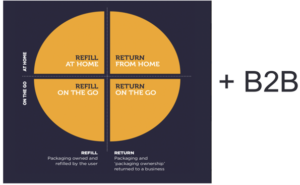Background
Reusable packaging used to play a bigger role in our economy, but post WWII single-use packaging became dominant, offering highly optimized systems to deliver goods to consumers. Many organizations worldwide are now trying to understand where, and how, reuse systems can be sustainable at scale. Reuse solutions typically require a packaging system conversion, including changes in logistics and supply-chain management.
Why Reuse
Research shows that consumers are willing to try reusable packaging, some types more than others. In certain cases these solutions are economically viable and environmentally preferrable to single-use options for the same product. Reuse is high on the waste hierarchy, but preferability compared to single-use is best determined on a case-by-case basis.
Definition
There is no globally accepted definition for reusable packaging, but this is often cited:
“packaging that has been conceived, designed and placed on the market to accomplish within its life cycle multiple trips or rotations by being refilled or reused for the same purpose for which it was conceived (DIRECTIVE (EU) 2018/852).”
The language “for the same purpose” is important, because it distinguishes reusable packaging from, for example, repurposed packaging. Reuse systematically replaces single-use, repurposing does not. Example: a takeout food container may be repurposed for various things but if one reorders takeout, another single-use container must be provided.
The language of “multiple trips” begs the question of what constitutes a reusable package? There is no standard of X# of uses = reuse viability, because materials and systems vary widely.
This article provides practical insight, and signals the need for common terms and metrics. And this initiative is developing a set of global standards.
A lack of standards had led to, for example, markets flooded with ‘reusable’ shopping bags, many of which are poorly designed.
Defining Reusable Packaging by type
The EMF offers a helpful way to distinguish 4 types of business-to-consumer (B2C) reusable packaging.

Key takeaways when considering reusable packaging includes:
- ‘Reusable Packaging’ is the general solution space.
- Package ownership, and location of reuse are important and generate the four types of B2C reusable packaging.
- With respect to ownership, in Return systems a business typically owns the package, whereas in Refill systems the consumer typically owns the package.
- With respect to location, many consumers are familiar with ‘on-the-go’ models (e.g., beer bottle return, bulk refill). The rapid emergence of e-commerce has led to home-based solutions (e.g., concentrated refills by subscription).
B2B reusable packaging is considered separately. There are many longstanding examples here, including pooled systems for pallets and reusable plastic containers (RPCs), along with a great deal of innovation. For further information, see The Reusable Packaging Association
Supporting Resources
Connecting with Other Actors:
Canada Plastics Pact (CPP): Reuse Rapid-Action Group
Reuse Portal (Global): United Nations Environment Programme, World Wildlife Fund and World Economic Forum (2022): open collaborative platform providing users access to practical guidance, tools and networks to take action.
Planet Reuse (Global): a data sharing platform and network space dedicated only for the reusable packaging community.
KIDV Community of Practice for Reusable Packaging
Investment/Movement Building
Reuse Catalyst: Facilitated by the U.S. Plastics Pact, in collaboration with Closed Loop Partners, the Reusable Packaging Association, and World Wildlife Fund, the Reuse Catalyst aims to bolster the development of emerging and established reuse and refill innovators.
PR3’s Reusable Packaging System Design Standard (US, SE Asia). PR3 is developing a Reusable Packaging System Design Standard to support the scaling of reusable packaging and infrastructure, with the aim of transforming the current landscape of disconnected, small-scale, reuse programs and pilots into full-scale, interoperable public-private systems. The first company to use the standard Reuse symbol, the reuse Rose, was Muuse Canada.
Collaborative Initiative Examples
- Vancouver return-on-the-go pilot with Return-It and Tim Hortons allows customers to return cups to restaurants or Return-It stations, inc. transit stations and other locations.
Webinar: https://www.pac.global/resources/return-it-to-reuse-it-and-recycle-it-webinar/ - Reuse Seattle involves municipal government, return-on-the-go reuse service providers, event venues, restaurants and promotional partners.
- Refill Coalition (UK): a pre-competitive, multi-retailer (supermarket) initiative to create the world’s biggest refill trial (refill-on-the-go and refill-from-home).
General Guides, Reports and Related Studies
Dillon Report for CPP (need updated version with full appendices)
Guidance for Reusable Packaging (US): Sustainable Packaging Coalition (2022 – 50pp): helps user understand goals and assumptions for design of a successful reuse program.
Reuse – Rethinking Packaging Report (Global): EMF (2019): helps reader understand reuse models by identifying key benefits and implementation challenges. Evaluates 100+ initiatives, based on interviews with 50+ experts.
Related detailed studies
LCA (2023): Takeout Food Containers (Return)
LCA (2021): Takeout Food Containers (Refill and Return; interesting because it addresses consumer behaviour to better understand barriers to scale)
Report (2022): UK Grocery Retailer Tesco on trial with Loop (Return)
Report (2021): US NGO Upsteam, LCA-based (Return)
Report (2022): Reuse-Refill Canada (Refill)